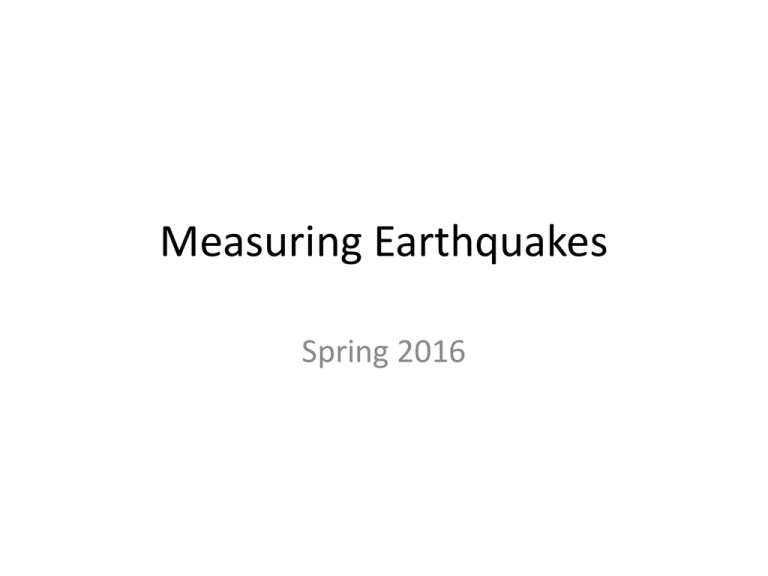File - Miss Fogg Science
advertisement

Measuring Earthquakes Spring 2016 8.2 Measuring Earthquakes Earthquake Waves Seismographs are instruments that record earthquake waves. Surface waves are seismic waves that travel along Earth’s outer layer. Seismogram Seismograms are traces of amplified, electronically recorded ground motion made by seismographs. 8.2 Measuring Earthquakes Earthquake Waves Body Waves • Identified as P waves or S waves • P waves – “primary waves” - Are push-pull waves that push (compress) and pull (expand) in the direction that the waves travel - Travel through solids, liquids, and gases - Have the greatest velocity of all earthquake waves 8.2 Measuring Earthquakes Earthquake Waves Body Waves • S waves – “secondary waves” - Seismic waves that travel along Earth’s outer layer - Shake particles at right angles to the direction that they travel - Travel only through solids - Slower velocity than P waves A seismogram shows all three types of seismic waves—P waves, and S waves, and surface waves. 8.2 Measuring Earthquakes Earthquake Waves Surface waves • S waves – “secondary waves” - Seismic waves that travel along Earth’s outer layer - Shake particles at right angles to the direction that they travel - Travel only through solids - Slower velocity than P waves A seismogram shows all three types of seismic waves—P waves, and S waves, and surface waves. P waves – compression waves S waves – shear waves Surface waves Surface Waves – Both P and S waves that reach and travel along the Earth’s surface to cause damage. Calculating the speed of earthquake waves Use the following equation to calculate the speed (velocity) of earthquake waves: distance Velocity (speed) time 8.2 Measuring Earthquakes Locating an Earthquake Earthquake Distance • The epicenter is located using the difference in the arrival times between P and S wave recordings, which are related to distance. Earthquake Direction • Travel-time graphs from three or more seismographs can be used to find the exact location of an earthquake epicenter. Earthquake Zones • About 95 percent of the major earthquakes occur in a few narrow zones. Locating an Earthquake 8.2 Measuring Earthquakes Measuring Earthquakes Historically, scientists have used two different types of measurements to describe the size of an earthquake —intensity and magnitude. Richter Scale • Based on the amplitude of the largest seismic wave • Each unit of Richter magnitude equates to roughly a 32-fold energy increase • Does not estimate adequately the size of very large earthquakes 8.2 Measuring Earthquakes Measuring Earthquakes Momentum Magnitude • Derived from the amount of displacement that occurs along the fault zone • Moment magnitude is the most widely used measurement for earthquakes because it is the only magnitude scale that estimates the energy released by earthquakes. • Measures very large earthquakes Earthquake Magnitudes Some Notable Earthquakes









